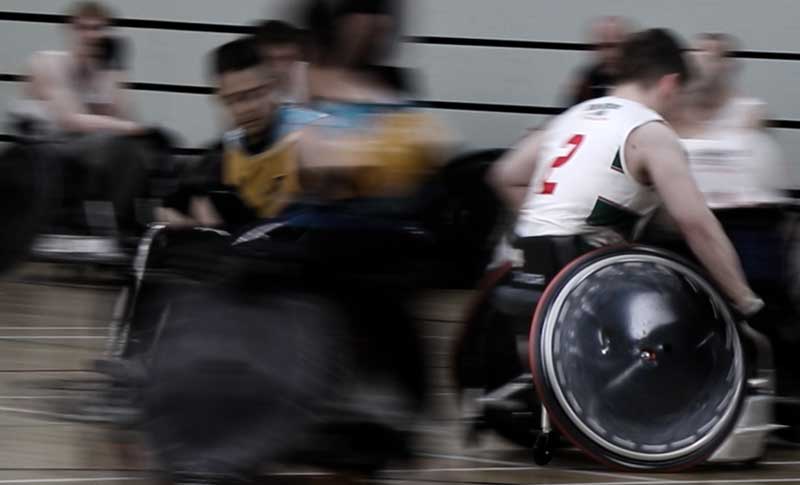"To appreciate where you are, you must recognize the history of where it all began." This sentiment holds true throughout the world of seating and mobility.
In July 2022, the USA Low Point Wheelchair Rugby team competed at the World Games in Birmingham, AL. The teams that competed made history, as this event marked the first time the World Games showcased a wheelchair sport.5 As an international sporting event, the World Games hosts 3,600 athletes from over 100 countries that travel to compete in more than 30 unique sporting events.5
It was certainly an exciting time for those in the wheelchair rugby community, but where did it all begin?
Originally known as "murderball" due to the heavy hitting and physical nature of the game, the sport of wheelchair rugby was created in Canada in 1977 by athletes with quadriplegia that were in search of a sport that would allow people with limitations in upper extremity function to participate.6 Combining elements of rugby, basketball, and handball, athletes participated in what could be called their "everyday" wheelchairs, and murderball became quite the sensation. After being introduced to the sport by Canadian players, Brad Mikkelsen is credited for the introduction of murderball to the United States.7

As the sport continued to gain momentum on the world stage, the 1980s saw the name of the sport change to become known as "quad rugby" in the U.S., and "wheelchair rugby" worldwide. Mikkelsen coined the name "quad rugby" as a double meaning, to include 4 vs. 4 players on the court, and quadriplegic athlete participation.7 Thus, in 1988 the United States Quad Rugby Association (USQRA), now known as the United States Wheelchair Rugby Association (USWRA), was founded to promote and support quad rugby in the U.S.3
Then in 1990, a para-sport specific classification system was developed based on the individual athlete's impairment.2 It was determined that classification be conducted by personnel with appropriate medical training, and has grown to include muscle testing, skills testing, and court testing. Furthermore, while it is important to remember that wheelchair rugby was originally created for those with spinal cord injuries, the sport has grown to include individuals with various other neurological conditions and amputations. Athletes are classified on a scale from 0.5 to 3.5 (female athletes being provided a 0.5-point addition), and the total classification of a team's four players cannot exceed 8.0 on the court (point additions are allows only with a female athlete).
Furthermore, as the sport evolved in the early 1990s, so did the equipment. Beginning around 1992, players began to leave their everyday chairs on the sidelines in favor of utilizing sports-specific chairs that were lighter weight, more durable, and even more tolerant of the high impact nature of the game.
With a comprehensive system in place, wheelchair rugby was officially recognized as a sport in 1993 with the founding of the International Wheelchair Rugby Federation.5 Soon after, in 1994, the International Paralympic Committee recognized wheelchair rugby as a Paralympic sport, ahead of its debut in the Summer Olympics in Atlanta in 1996.5 Finally, wheelchair rugby became a medal event in the Summer Olympics in Sydney in 2000.3 The U.S. would take home the gold medal at those games3, setting the stage for the illustrious USA Wheelchair Rugby program.
Since that time, wheelchair rugby has grown within the United States and around the world. Within the U.S., the United States Wheelchair Rugby Association is composed of more than 40 teams with over 500 athletes across the country.2 Around the world, wheelchair rugby is now played in various forms, including Paralympic wheelchair rugby, low point wheelchair rugby, and wheelchair rugby 5s.1 Additionally, wheelchair rugby chairs have continued to evolve, now including high-, mid-, and low-point style frames that are individually made of either aluminum or titanium to meet the needs of individual athletes.
If you or someone you know is interested in participating in wheelchair rugby, please reach out to the WWR or the USWRA. Whether you're looking to play, spectate, or volunteer, wheelchair rugby offers an inclusive community for all!
And if you have sport-specific wheelchair questions, you can start your research by consulting with an RGK Genius today.
References
- About WWR. (2021). World Wheelchair Rugby. Retrieved July 25, 2022, from https://worldwheelchair.rugby/about-wwr/
- Hart, A., Newell, E., & Ungerer, G. (n.d.). WWR Classification Rules (No. 4). World Wheelchair Rugby. https://worldwheelchair.rugby/wp-content/uploads/2021/12/WWR-Classification-Rules-2022.pdf
- Role of The USWRA. (2022). United States Wheelchair Rugby Association. Retrieved July 25, 2022, from https://www.uswra.org/role-of-uswra
- Wheelchair rugby. (2022). International Paralympic Committee. Retrieved July 25, 2022 from https://www.paralympic.org/wheelchair-rugby
- The World Games 2021. (2022, February 9). The World Games. Retrieved July 25, 2022, from https://twg2022.com/thegames/
- USA Wheelchair Rugby About. (2022). USA Wheelchair Rugby. Retried July 25, 2022 from https://usawr.org/about/
- USQRA. (2018). Brad Mikkelsen. Retrieved July 26, 2022 from https://www.usqra.org/brad-m-1998
Sarah Leonard PT, DPT, ATP specializes in neuro rehab with experience in spinal cord injury and brain injury rehabilitation. As a PT, Sarah has trained under industry-leading professionals who fostered her love for complex rehabilitation technology. As an ATP, Sarah has experience working for a national complex rehabilitation technology supplier. Additionally, Sarah presently serves as the assistant coach for the United States Wheelchair Rugby Association Low Point Team and has been an active participant in adaptive sports and recreation throughout her career.